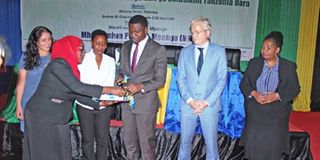Quality of life improves in Tanzania: World Bank

Industry and Trade minister Innocent Bashungwa (middle) cuts the ribbon to launch the Tanzania Mainland Poverty Assessment report in Dodoma yesterday. PHOTO | SHARON SAUWA
Dodoma. Poverty in Tanzania has been falling for a decade, but recently the pace has slowed, raising concern about lack of correlation between economic growth and poverty reduction rate.
The Tanzania Mainland Poverty Assessment Report by the World Bank Group shows that between 2007 and 2018 Tanzania’s national poverty rate fell from 34.4 to 26.4 percent.
The report which was launched yesterday by Industry and Trade minister Innocent Bashungwa attributed the trend to gradual improvement in living conditions and human capital.
The country’s strategy to diversify toward solar energy has started to pay off, particularly in rural areas, where 33 percent of households use solar energy for lighting compared to 14 percent in urban areas.
“Last year Tanzania recorded sustained increase in access to basic services and improvement in human capital outcomes,” reads a report in part.
However, Tanzania’s success is not unmitigated as poverty was not reduced as much as the population grew.
This resulted in the last year’s increase in the absolute number of poor people, with about 14 million, up from 13 million people in 2007 people reportedly to have been living below the national poverty line of Sh49,320 per adult equivalent per month. “Poverty reduction has not been responsive to Tanzania’s remarkable economic growth, and inequality has worsened,” reads a report in part
The growth elasticity of poverty indicates that a 10 percent increase in Gross Domestic Product (GDP) growth per capital can be expected to reduce the proportion of the poor by about 4.5 percent—low compared to estimates for other developing countries.
This, according to the report is due to both the concentration of employment in slow-growing sectors and the slow transformation of the economy.
Based on national accounts data, industry and services are growing much faster than agriculture, driving the growth and transformation of the economy.
However, the fastest growing subsectors each employ on average no more than three percent of the general population.
They also tend to employ significantly more educated Tanzanians, with their workers who have completed secondary and above exceeding 60 percent on average.
Lack of education and productive resources hold people back from improving their economic standing by moving to more productive sectors.
Only those equipped with more human capital and assets are able to benefit from the opportunities generated by economic growth---they increase their incomes and consumption much faster than the rest of the population.
The result is more inequality, which eventually deters efforts to eradicate poverty.
Slow progress in poverty reduction has pushed up the number of poor people, leaving a noticeable share of the population still at risk of at least transitory poverty.
“Vulnerability is still high, with findings showing that for every four Tanzanians who moved out of poverty, three fell into it, according to the report.
“A large number of non-poor people living just above the poverty line are at risk of slipping below it,” reads a report in part.
It is hard for the poor to achieve a better life because of a large number of dependents, low human capital, low-profile jobs, and limited access to basic services and assets.
Poor households are burdened by large numbers of dependents and disadvantaged by too little education.
The number of children under 15 in poor households is almost double the number in non-poor households.
Poor households also have significantly higher dependency ratios, with report showing that about 44 percent of households with five or more children under 15, are poor.
The report further pointed out that the drivers of poverty are mutually reinforcing and carry across generations.
“The poor start life at a disadvantage, and many pass poverty onto their offspring,” reads a report in part.
“They are hobbled by, among other deficits, limited resources, malnutrition and health problems, poor access to social services and health care, and low education and skills.
“They lack income, can save little for the future, are vulnerable to shocks, and have limited coping strategies.”
Beyond the urban-rural divide, geographic disparities in poverty are substantial, with the report showing major disparities in the incidence of poverty and the distribution of poor people across the country.
By region, poverty ranges from as high as 45 percent in Rukwa to as low as eight percent in Dar es Salaam.
Overall, about 33 percent of the poor are concentrated in the highly rural lake zone, where less productive and subsistence activities are common.
Structural transformation, an integral part of the development process, will determine whether Tanzania can pull itself out of poverty.
A central aspect of any policy for curbing poverty and reducing the absolute number of poor would be creation of enough productive jobs to absorb the emerging young generation of workers.
“Although small firms dominate the economy and provide most of the jobs, medium and large firms could create jobs fast,” suggests the report in part.
However, the report warned, limited access to finance and the need to rely heavily on family networks and informal funding are barriers to emergence of a vibrant private sector. Noting that the government was implementing the large strategic projects, Minister Bashungwa, urged Tanzanians to work round the clock, in an effort to fight poverty.
“I’m optimistic with execution of large strategic projects, poverty rate will fall even further below the current 26.4 per cent,” noted Mr Bashungwa.
He called on his fellow leaders to use the report’s findings in execution of the Tanzania Development Vision 2025, which is meant to transfer Tanzania to a middle income country.




